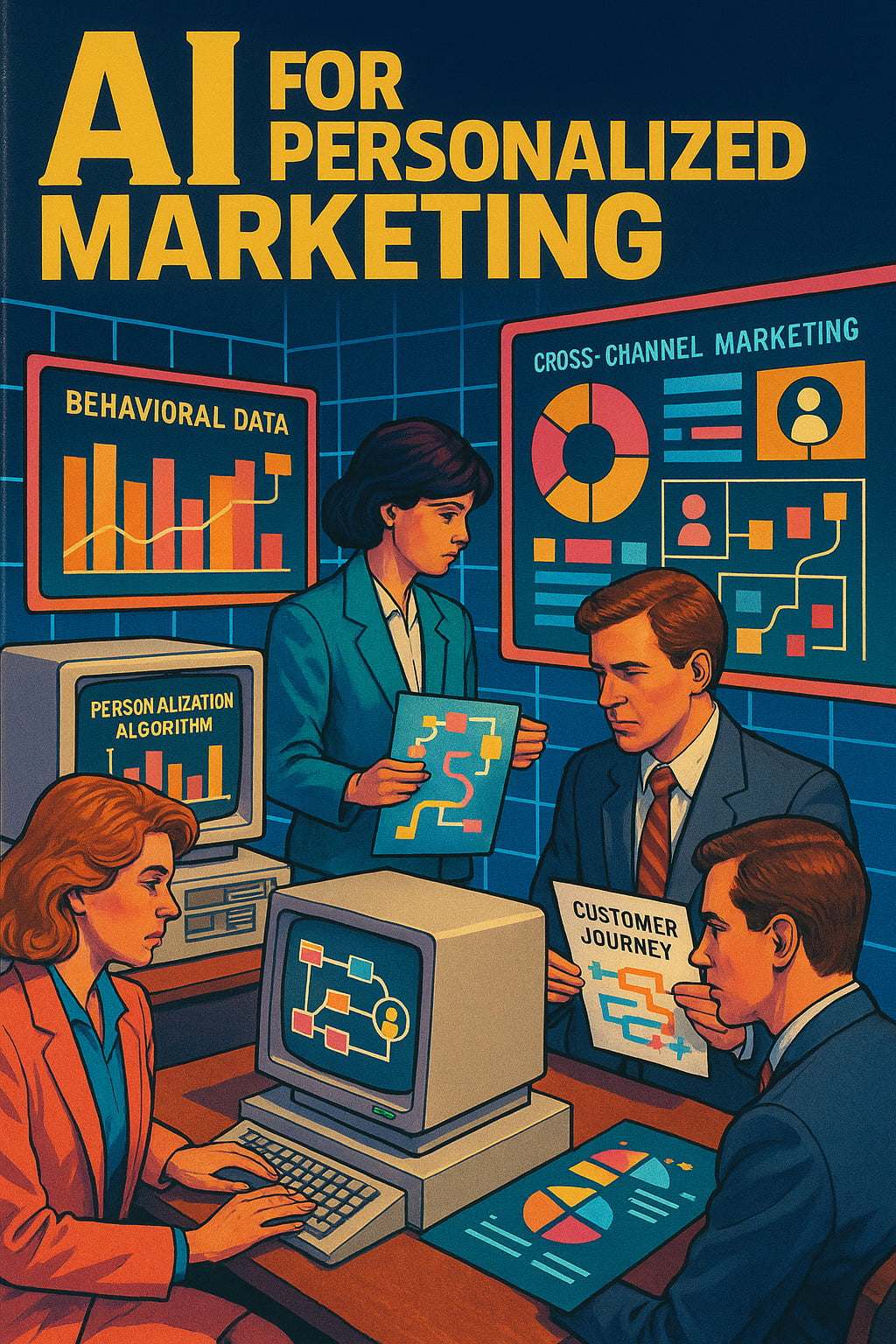AI for Personalized Marketing



This Is What AI for Personalized Marketing Actually Looks Like in 2025
AI for personalized marketing isn't revolutionary—it's evolutionary. The technology has existed for years, but 2025 marks the inflection point where AI-driven personalization has matured from experimental algorithms into operationally viable systems that marketing teams can actually deploy at scale.
The fundamental shift lies in sophistication. Where early AI implementations delivered basic product recommendations based on purchase history, today's machine learning systems process multi-dimensional data sets to generate nuanced customer profiles. These systems analyze behavioral patterns, engagement timing, content preferences, and contextual signals to deliver personalization that extends beyond "customers who bought X also bought Y."
Machine learning now drives granular audience segmentation that identifies micro-cohorts within your customer base. Advanced natural language processing analyzes customer communications to understand sentiment and intent. Predictive analytics anticipate customer needs before they manifest. The result: marketing campaigns that achieve relevance through precision rather than volume.
What Powers AI Personalization
AI personalization operates on three distinct data processing architectures, each employing specific algorithmic approaches within the marketing intelligence pipeline.
Historical Data Analysis leverages offline machine learning techniques optimized for large-scale batch processing. Apache Spark MLlib and Hadoop MapReduce frameworks process terabytes of transactional data using dimensionality reduction techniques like Principal Component Analysis (PCA) and t-SNE to identify latent customer behavior patterns. Time series analysis employs ARIMA models and Prophet algorithms to detect seasonal purchasing cycles, while cohort analysis calculates customer lifetime value using survival analysis and Kaplan-Meier estimators.
Advanced customer segmentation uses unsupervised learning algorithms including Gaussian Mixture Models (GMM) and spectral clustering to identify behavioral cohorts that transcend traditional demographic boundaries. These models generate probabilistic customer profiles with confidence intervals, enabling risk-adjusted personalization strategies.
Real-Time Data Processing employs stream processing architectures that handle 100,000+ events per second with sub-100ms latency requirements. Event-driven microservices architecture processes clickstream data, email interactions, and social media signals through Apache Kafka message queues. Machine learning inference engines—deployed on containerized Kubernetes clusters—execute pre-trained models for real-time scoring.
Feature stores cache pre-computed customer attributes while streaming feature engineering pipelines calculate real-time metrics like session duration, page depth, and interaction velocity. Online learning algorithms continuously update model parameters using stochastic gradient descent, enabling personalization systems to adapt to behavioral shifts without full model retraining.
Predictive Analytics represents the most computationally intensive layer. Ensemble methods combine multiple algorithmic approaches: gradient boosting machines (XGBoost, LightGBM) for structured data predictions, recurrent neural networks (LSTM, GRU) for sequential behavior modeling, and transformer architectures for content analysis. These systems generate propensity scores, churn probabilities, and next-best-action recommendations with quantified uncertainty estimates.
The feature engineering pipeline processes over 500 behavioral variables including clickstream patterns, engagement velocity metrics, content consumption sequences, and cross-channel attribution paths. Advanced techniques like deep factorization machines and neural collaborative filtering model complex feature interactions that traditional linear models cannot capture.
Data infrastructure requirements include distributed computing clusters capable of processing 10TB+ datasets, real-time databases supporting microsecond query latencies, and MLOps pipelines for continuous model deployment and monitoring. Cloud-native architectures leverage auto-scaling compute resources and managed services to handle variable workloads cost-effectively.
Privacy-preserving techniques include differential privacy algorithms that add calibrated noise to training data, federated learning approaches that train models without centralizing sensitive information, and homomorphic encryption methods that enable computation on encrypted data. These technical safeguards ensure compliance with GDPR, CCPA, and emerging privacy regulations while maintaining personalization effectiveness.
Best Practices for Using AI for Personalized Marketing
Effective AI personalization requires systematic implementation across data management, channel strategy, and customer experience design.
Data Quality Management represents the critical foundation. Feed current, verified customer data into AI systems regularly. Outdated or incomplete data sets generate inaccurate personalization that undermines campaign effectiveness. Implement data validation protocols and establish refresh cycles for customer information.
Channel-Specific Deployment maximizes impact. Deploy AI personalization on channels where your target audience demonstrates highest engagement. Email marketing, display advertising, and website experiences typically yield strongest results due to rich behavioral data availability.
Personalization Calibration prevents customer alienation. Avoid over-personalization that feels invasive or manipulative. Use progressive profiling to gradually increase personalization depth based on customer engagement levels. Test personalization intensity across customer segments to identify optimal customization levels.
Performance Monitoring ensures continuous optimization. Track key metrics including click-through rates, conversion rates, and customer satisfaction scores. Implement A/B testing frameworks to measure personalization effectiveness against control groups.
Cross-Channel Consistency maintains brand coherence. Ensure personalized messaging aligns across all customer touchpoints. Inconsistent personalization creates confusing customer experiences that damage brand trust.
How AI Personalization Works at Scale: Data, Tools, and Execution
At the core of successful AI personalization is a robust infrastructure for collecting, analyzing, and applying customer data across marketing touchpoints. Today’s AI-powered platforms don’t just automate personalization—they refine it by continuously learning from user behavior, preferences, and real-time interactions.
Modern marketing teams rely on advanced AI tools and marketing automation tools to execute personalized marketing strategies that go far beyond simple name insertions in email subject lines. These systems analyze data from vast datasets, including behavioral signals, purchase history, and customer segmentation models, to craft personalized content that aligns with individual customer preferences.
The implementation of AI personalization tools enables brands to create highly targeted campaigns, adapting dynamic website content and marketing messages based on a visitor’s intent, location, device, or journey stage. This level of customization increases efficiency by helping marketers automate repetitive tasks while preserving contextual relevance.
What sets apart successful companies is their ability to integrate data from multiple sources—CRMs, email platforms, web analytics, and social listening tools—to generate data-driven insights. These insights guide everything from content personalization to social media posts, ensuring the right message reaches the right person at the right time.
Moreover, artificial intelligence and machine learning capabilities are increasingly used to predict future customer behavior and optimize outcomes. Whether it's anticipating churn, improving customer relationships, or fine-tuning key performance indicators, AI-driven systems offer a layer of foresight that manual approaches can’t match.
When implementing AI personalization, it’s essential to maintain transparency and protect privacy. As organizations collect data, they must clearly communicate how it’s used to personalize experiences—turning ethical handling of information into a competitive advantage.
In the hands of empowered marketing teams, AI-powered personalization becomes more than a convenience—it becomes a strategic lever to increase customer engagement, streamline marketing efforts, and elevate the customer journey.
When to Use AI vs When to Leave It Alone
AI excels in data-intensive, pattern-recognition tasks but requires human oversight for strategic and creative decisions.
Deploy AI for:
- Optimal send time determination based on individual engagement patterns
- Automated segmentation using behavioral and demographic variables
- Dynamic content selection based on browsing history and preferences
- Predictive customer lifetime value calculations
- Automated bid optimization for paid advertising campaigns
- Customer feedback analysis and sentiment monitoring
- Real-time website personalization based on visitor behavior
- Abandoned cart recovery sequence automation
Maintain Human Control for:
- Brand voice and tone development
- High-level campaign strategy and messaging frameworks
- Creative concept development and artistic direction
- Legal compliance review for regulated industries
- Crisis communication and sensitive customer issues
- Complex product launch strategies
- Executive-level strategic planning
- Cross-functional campaign coordination
The distinction centers on pattern recognition versus strategic thinking. AI processes data to identify opportunities; humans provide context, creativity, and strategic judgment that algorithms cannot replicate.
Why Personalized Marketing Still Falls Flat
Despite technological advances, personalized marketing frequently fails due to implementation errors and strategic misalignment.
Over-Segmentation creates meaningless micro-audiences. Brands often segment customers into increasingly narrow categories that lack statistical significance. This approach generates personalization that feels arbitrary rather than relevant. Effective segmentation requires balancing granularity with actionable audience size.
Tone-Deaf Automation ignores contextual nuance. AI systems that prioritize engagement metrics over customer experience produce personalization that feels mechanical. Automated systems may send promotional messages during inappropriate times or fail to recognize customer service issues that require human intervention.
Behavioral Signal Misinterpretation leads to counterproductive personalization. Algorithms that misread customer intent—interpreting research behavior as purchase intent or treating one-time purchases as recurring preferences—generate irrelevant recommendations that frustrate customers.
Data Underutilization represents a critical missed opportunity. Many brands focus on transactional data while ignoring rich behavioral signals. Browsing history reveals content preferences. Social media engagement indicates brand affinity. Customer service interactions provide sentiment insights. Support ticket analysis reveals product satisfaction levels.
These underused data points significantly impact customer engagement, marketing effectiveness, and customer satisfaction when properly integrated into AI personalization systems. The challenge lies in connecting disparate data sources to create comprehensive customer profiles that inform truly relevant personalization.
Examples of AI Personalization That Actually Help Customers
Successful AI personalization enhances customer experience through relevant, timely communications that add genuine value.
Behavioral Trigger Campaigns demonstrate practical AI application. E-commerce brands use machine learning to identify optimal timing for post-purchase communications. Instead of generic follow-up emails, AI systems analyze individual customer behavior to determine when customers typically engage with educational content, product recommendations, or loyalty programs.
Dynamic Website Experiences adapt content based on visitor behavior. SaaS companies implement AI systems that modify homepage content, feature highlights, and call-to-action placement based on referral source, previous interactions, and demographic signals. This approach increases conversion rates by presenting relevant information to each visitor segment.
Predictive Customer Service anticipates support needs. Telecommunications companies use AI to identify customers likely to experience service issues based on usage patterns, network data, and historical support interactions. Proactive outreach with relevant solutions prevents customer frustration while reducing support volume.
Contextual Content Recommendations enhance user experience. Media companies leverage AI to analyze viewing history, genre preferences, and engagement patterns to suggest relevant content. Unlike generic popularity-based recommendations, these systems consider individual taste profiles and viewing context to improve content discovery.
Intelligent Ad Targeting matches messaging to individual preferences. Retail brands use AI to analyze purchase history, browsing behavior, and demographic data to deliver advertisements that feature relevant products at optimal times.This approach increases ad effectiveness while reducing customer annoyance from irrelevant promotions.
Wrapping Up
AI for personalized marketing represents a capability amplifier, not a replacement for strategic thinking. The technology excels at processing vast data sets to identify patterns and opportunities that human analysis cannot match. However, successful implementation requires human expertise to provide context, creativity, and strategic direction.
The most effective personalized marketing combines AI's analytical power with human insight about customer needs and brand positioning. Technology enables precision; strategy ensures relevance. The brands that excel at personalization understand this balance, using AI to enhance human decision-making rather than replace it.
Strong personalization ultimately depends on understanding your audience and crafting messages that resonate with their specific needs and preferences. AI provides the tools to achieve this understanding at scale, but success requires ongoing commitment to data quality, customer privacy, and strategic alignment between technology capabilities and business objectives.


.svg)